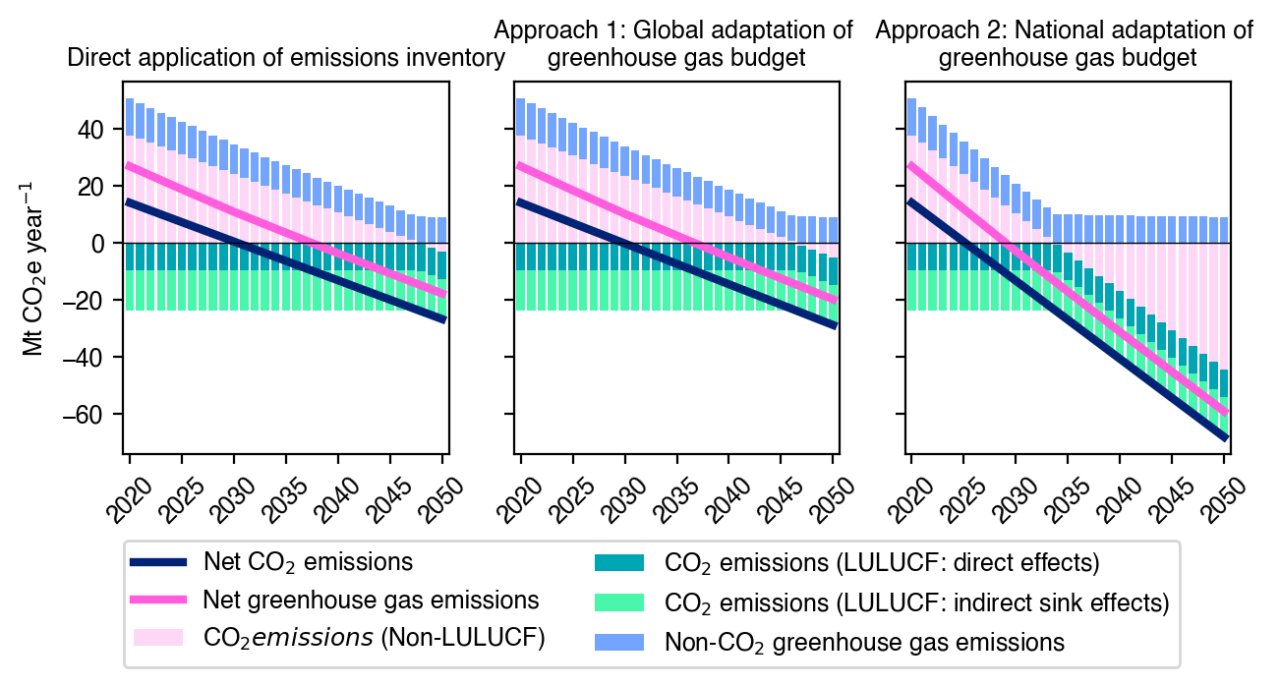Previous assessments by the Panel used the inventory calculation approach, on which climate policy is based. This new report examines carbon neutrality and the emissions budget (i.e. the total amount of greenhouse gas emissions) through climate science modelling and definitions from the Intergovernmental Panel on Climate Change’s (IPCC) scientific reports. Based on the results, there is no reason to change the Panel’s recommendations for Finland’s emissions reduction pathway.
A review between scientific methods
In 2021, the Finnish Climate Change Panel produced a review and recommendation for a globally fair net emissions reduction pathway for Finland, which would be consistent with the Paris Agreement’s target of keeping global warming to no more than 1.5 °C. The national emissions reduction targets set out in the Finnish Climate Act and the target of achieving carbon neutrality by 2035 are in line with the Panel’s recommendation.
Approaches to global carbon sinks and climate modelling have evolved since the Panel’s earlier recommendation. Therefore, the Panel has now carried out a methodological review comparing the greenhouse gas inventory methodology that underpins climate policy with climate science modelling. The analysis takes better account of non-CO2 greenhouse gases and so-called indirect sink effects as a completely new part of the national emissions budget calculation.
“Depending on the approach used, greenhouse gas emissions will reach a level where they are, at most, equal to removals around 2029–2037,” says the lead author of the report, Senior Research Scientist Antti-Ilari Partanen of the Finnish Meteorological Institute.
Non-CO2 emissions in this context are methane (CH4), nitrous oxide (N2O) and fluorinated greenhouse gases (F gases). Indirect sink effects include, for example, the change in forest growth due to global warming and increased CO2 concentrations, and the effects of global warming on soil emissions compared to the pre-industrial climate.

Carbon neutrality by 2035 is a legitimate target and its implementation must be ensured
The carbon neutrality target and the net emissions reduction pathway leading up to it serve as an answer to the question: in the global context, how much of the global carbon budget under the 1.5 °C threshold set by the IPCC is it fair for Finland to shoulder?
The 2035 carbon neutrality target in the Finnish Climate Act is one of the first science-based national climate targets in the world.
“In light of the principle of fairness based on the ability to pay, it is a justified target for Finland’s climate policy, including when viewed from a climate science perspective,” emphasises member of the Finnish Climate Change Panel Research Professor Hannele Korhonen of the Finnish Meteorological Institute.
The 2035 target is supported by the Panel’s assessments regarding feasible climate actions to achieve carbon neutrality. There is sufficient time to achieve the carbon neutrality target, provided we speed up the process of reinforcing the natural and technological sinks and make rapid enough progress on emissions reductions.
In the emissions trading sector, the reduction in fossil fuel emissions in Finland is progressing even faster than expected. This could allow the carbon neutrality target to be achieved at a lower net sink level than the historical average for the land-use sector. Emissions reductions can be accelerated further, and the net sink, i.e. the sum of carbon removals and soil emissions, must be strengthened. Cost-effective, emission-reducing and sink-boosting measures must be put in place immediately in the land-use sector. Technological sinks are also needed to support an increase in the net sink of the land-use sector.
The comparison between methods highlights the impact of non-CO2 emissions. Methane, in particular, has a substantial effect on heating the atmosphere in the short term. Climate actions may be needed to also target non-CO2 greenhouse gas emissions in order to avoid exceeding the 1.5 °C threshold.
According to the Panel, achieving carbon neutrality by 2035 is also important for Finland from the perspective of reaping the benefits of the clean transition.
Global climate policy requires harmonisation
The present methodological review shows that the Paris Agreement can be applied differently from country to country, even when done in a way that is justified by climate science. If countries were to apply the same principle of fairness, the 1.5 °C threshold could still be exceeded, as the indirect sink effect and non-CO2 emissions should also be accounted for in the same way.
“Making the calculation principles of national targets visible and harmonising the calculation between countries may be necessary in the development of UN climate policy,” says Chair of the Finnish Climate Change Panel Professor Jyri Seppälä of the Finnish Environment Institute.
The next United Nations Climate Change Conference, COP29, will take place 11–22 November 2024 in Azerbaijan. Panel Chair Jyri Seppälä will attend as a representative of the Finnish Climate Change Panel.




